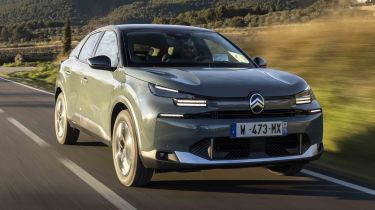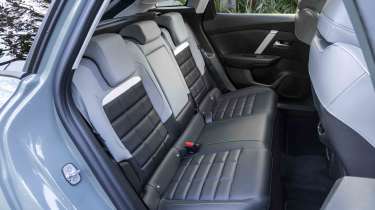Citroen C4 review
The comfortable Citroen C4 undercuts many of its established family car rivals, making it hard to overlook

Is the Citroen C4 a good car?
A recent facelift hasn’t brought massive improvements to the Citroen C4; the newest Hybrid 136 powertrain actually arrived in the final few months of the old car’s lifespan. Citroen’s family hatch feels cheap in places and its technology isn’t especially cutting-edge, but it’s now treading a value-driven path few other manufacturers can seemingly compete with. A few small tweaks here and there are welcome, but as ever the ride remains the outstanding part of the C4’s drive.
| Key specs | |
| Fuel type | Petrol, hybrid, electric |
| Body style | Hatchback |
| Powertrain | 1.2-litre three-cylinder mild-hybrid 50kWh battery, 1x e-motor, front-wheel drive 54kWh battery, 1x e-motor, front-wheel drive |
| Safety | 4 stars Euro NCAP |
| Warranty | Two years/60,000 miles |
How much does the Citroen C4 cost?
The boldly styled French hatchback was launched in its current fourth generation in 2020, and has proven to be a huge seller for the brand, with 270,000 models finding buyers last year. Looking to maintain this chunky slice of the segment, Citroen revealed the facelifted C4 at the Paris Motor Show in autumn 2024, introducing a fairly significant shift for the exterior look.
The jacked-up hatch bodystyle remains, meaning the C4 continues its two-pronged fight against traditional hatchbacks such as the Vauxhall Astra and Volkswagen Golf as well as small crossovers such as the Mazda CX-30 and Ford Puma. The powertrain line-up spans pure petrol, two petrol mild-hybrids and a full EV in the Citroen e-C4, while there’s also the booted Citroen C4 X saloon, which also received a mid-life refresh alongside the C4, despite only joining the range in 2022.
Used - available now
Citroen announced major price cuts when it launched the new C4 and e-C4 in late 2024, with up to £5,600 off the list price. The most basic C4 You with the less-powerful mild-hybrid Hybrid 100 kicks off at just £22,295. This undercuts fellow Stellantis products such as the Vauxhall Mokka and Jeep Avenger by several thousands of pounds. The mid-range Plus trim starts from £23,385 with the PureTech 130 petrol engine, while the more powerful Hybrid 136 costs from £24,735. The most lavishly-equipped Max starts at £25,275 with the PureTech 130, rising to £26,625 for the Hybrid 136. The all-electric e-C4 can be had in You and Plus trim with a 50kWh battery from £26,295 and £27,360 respectively. The e-C4 with the larger 54kWh battery is only offered in Max trim from £30,150.
The C4 X line-up isn’t as varied, with only Plus trim including the Hybrid 136 and smaller battery e-C4 X. Max specification replaces that smaller battery option with the larger battery.
Engines, performance & drive
On the move in the Citroen C4, it’s quickly apparent from its wonderfully cosseting seats and standard-fit ‘hydraulic cushions’ (bump stops to you and me) are extremely effective at filtering out most potholes and road imperfections. Citroen has been keen to promote the comfort delivered by the C4, and it’s particularly apparent in the ride.
The Hybrid 136 (introduced to the range in the last few months before the facelifted model was launched) features a 1.2-litre three-cylinder petrol engine and a six-speed dual-clutch automatic transmission with an in-built electric motor, the latter of which can provide an extra 28bhp and 55Nm of torque. There’s a Hybrid 100 too, which comes with the same overall layout as the Hybrid 136, but with 99bhp instead of 134bhp. The less powerful model is obviously slower to 60mph (by 2.7 seconds).
We’d like more engagement from the electrical side of the Hybrid 136 system in truth, because while the PureTech three-cylinder is a capable engine that serves many of Stellantis’s products well, it’s blown away for refinement by the all-electric Citroen e-C4. With the C4’s focus on ride quality, the engine’s occasional grumbles are a little at odds with this.
We thought the pre-facelift C4 was better when paired with the six-speed manual transmission (which has been axed for the facelift) rather than the eight-speed automatic, and the automatic-only Hybrid 136 is also letdown by its automatic gearbox. It’s a six-speed gearbox here and while it’s slick between shifts, it can be laggy to kick down when you need it to. This is not improved by using the paddle shifts on the steering wheel, because your commands are simply ignored by the C4 all too often.
The Citroen doesn’t claim to be a car you’ll regularly chuck into corners, but reassuringly it manages to hold the road well if you do decide to channel your inner Sebastien Loeb. The steering is light and requires an extra input or two to get some feel for the front wheels, although the C4 is agile enough when pushed hard. We also found the skinny eco-optimised tyres served up plenty of grip.
Front visibility is good thanks to a lofty driving position, but it’s less impressive at the rear, where despite a redesign the obstructive spoiler remains.
The all-electric e-C4 is offered with two battery choices – a 50kWh unit paired solely with a 134bhp front-mounted electric motor and a 54kWh battery with a 154bhp motor. There’s not much between the two in terms of straight-line poke and while the e-C4 feels smoother to drive than the slightly clunky C4 Hybrid 136, the steering, brakes and overall performance from the chassis are pretty similar – no surprise given the suspension settings are carried over from the C4. There’s no one-pedal driving offered in the e-C4, although ‘B’ mode does result in stronger regenerative braking, and for daily duties it’s the mode we’d always leave on.
| Model | Power | 0-62mph | Top speed |
| Citroen C4 Hybrid 100 | 99bhp | 10.7 seconds | 119mph |
| Citroen C4 Hybrid 136 | 134bhp | 8.0 seconds | 130mph |
| Citroen e-C4 | 154bhp | 9.2 seconds | 93mph |
0-62mph acceleration and top speed
If you’re after the fastest C4, then the 136bhp Hybrid version is the one to go for; 0-62mph is dispatched in 8.0 seconds, and the top speed is 130mph. The slowest C4 is, obviously, the least potent 99bhp Hybrid with a 0-62mph sprint time of 10.7 seconds and a 119mph top speed. The 129bhp petrol sits between the two, managing the same acceleration sprint in 9.4 seconds before going on to a top speed of 124mph.
If you predominantly drive around town, the 99bhp Hybrid will cope just fine, but it might be worth spending a bit more for either the 128bhp petrol or the 136bhp Hybrid for better out-of-town performance and easier motorway cruising.
The 134bhp e-C4 will sprint from 0-62mph in 10.0 seconds and hit a top speed of 93mph. Performance is best described as adequate, but where the e-C4 really shines is from 0-30mph, because all of the electric motor’s 260Nm of torque is available from the moment you touch the throttle. The e-C4 simply zips off the line – handy when driving in town. The 154bhp version is a little swifter off the mark, taking just 9.2 seconds to get from 0-62mph. The latter still has a 93mph top speed, though.
MPG, emissions & running costs
While the Citroen C4 has been refreshed on the outside, the powertrains available are familiar – although there is now no option of a six-speed manual for the PureTech petrol unit. The PureTech 130 three-cylinder, with its eight-speed automatic and stop-start technology, helps it reach a combined 50.7mpg with CO2 emissions standing at 131g/km.
The 48V mild-hybrid system of the Hybrid 136, meanwhile, isn’t just a token gesture towards lowering emissions, producing 107g/km in comparison. Citroen also claims up to 50 per cent of your driving can be done on electric power alone. While we think Citroen’s claim is optimistic, we found the mild-hybrid system chimed in quite regularly when cruising or during slow-speed manoeuvres.
The system on the Hybrid 100 matches the Hybrid 136 for emissions and economy, with both returning an average of 62.1mpg. For a mild-hybrid that’s not too shabby, and certainly helped by those aforementioned skinny tyres – which are even thinner than those on the C3 Aircross.
Company car drivers and those especially concerned by emissions might be better served by the all-electric e-C4, which is offered with 50kWh and 54kWh batteries. Both are in a lower Benefit-in-Kind (BiK) tax band than the Hybrid or petrol-only versions of C4.
| Model | MPG | CO2 | Insurance group |
| Citroen C4 Hybrid 136 | 62.1mpg | 107g/km | TBC |
| Citroen C4 PureTech | 50.7mpg | 131g/km | TBC |
| Citroen C4 Hybrid 100 | 62.1mpg | 107g/km | TBC |
Electric range, battery and charging
The e-C4 electric hatchback is offered with a choice of 50kWh and 54kWh batteries. The former allows for a maximum range of 219 miles, while the larger unit boosts the car’s range to 257 miles. The slipperier e-C4 X extends this to 222 miles with the 50kWh battery and 263 miles for the 54kWh version.
We’ve yet to test the 54kWh e-C4, but we covered more than 3,200 miles in a pre-facelift 50kWh e-C4 long-term test car and averaged 3.2 miles per kWh. That equates to a real-world range of 160 miles on a full charge.
Speaking of which, the e-C4 has a maximum charging speed of 100kW, which allows for a 10 to 80 per cent charge in half an hour for both versions, while a typical 7.4kW home wallbox will fully charge either version in around 7.5 hours.
| Model | Battery size | Range | Insurance group |
| Citroen e-C4 50kWh | 50kWh | 219 miles | TBC |
| Citroen e-C4 54kWh | 54kWh | 257 miles | TBC |
Depreciation
According to our expert data, the facelifted Citroen C4 in petrol and hybrid form is expected to hold on to around 45 per cent of its original value after three years or 36,000 miles; the all-electric e-C4 fares a bit worse at just 37 per cent.
To get an accurate valuation for a specific model, check out our free car valuation tool...
Interior, design & technology
When Citroen unveiled the striking Oli Concept in 2022, it claimed its design would soon filter down into production cars. This is clearly evident in the C4’s more rigid bodywork, angular LED lighting layout and the new Citroen badge, which sits prominently on the nose. While design is a matter of taste, there’s no doubt the latest Citroen C4 stands out from the crowd, while neatly adhering to the brand’s identity at the same time.
What is the Citroen C4 like inside?
It seems like most of the effort went into tweaking the exterior, though, because inside it’s virtually unchanged, aside from a new Citroen badge on the steering wheel, fresh bolstering for the seats and a fresh seat insert design.
What is the interior quality like?
The fit and finish help make the C4 feel plusher than a Dacia, but not quite up to the standard of a Volkswagen T-Roc, with a swathe of hard scratchy plastic on the dash the main offender. The key touchpoints, such as the gear selector (used across many Stellantis cars) and the leather steering wheel (standard on the C4), do help to lift the interior appeal somewhat. It seems well constructed, too, and during our tests, we didn’t uncover any annoying rattles or loose trim. On Max-trimmed cars, there’s a hidden drawer in the dash that can hold small laptops, tablets, or act as a secondary glovebox.
Sat-nav, stereo and infotainment
The 10-inch central touchscreen remains standard on all models, although it features an updated infotainment system that is simple enough to operate on the move. Air-vent controls no longer feature on the side – these are now reserved for the physical controls that have thankfully been retained in the centre on the dash. Items such as the ‘Application Drawer’ sub-menu are a bit of a faff, with it weirdly featuring the sat-nav as the bottom item.
The integrated nav itself isn’t the smoothest system, either, with the narrow, widescreen display not really an ideal size to display the map clearly. Apple CarPlay and Android Auto smartphone connectivity is standard-fit, providing a welcome alternative. As part of the Connect Plus Pack, our car also featured ChatGPT as a voice-recognition feature. But we found this less than useful, with several frustrating misunderstandings.
Opt for the base-spec You or mid-range Plus and you’ll get a five-inch colour screen for the driver – top-spec Max cars get a seven-inch instrument cluster instead. We wouldn’t base our buying decision on this, though, because they offer the same usability and features.
Boot space, comfort & practicality
The Citroen C4 definitely receives plus points for continuing to physical dials to operate the heating and air conditioning functions. Other Citroen models have located such functions within the infotainment system, making adjustments difficult while on the move. The head-up display that is standard on Max trim allows the driver to view key information such as speed limits and navigation directions without taking their attention away from the road.
Interior storage is good, with useful door bins and assorted cubbies, while Max trim includes a variable-height boot floor for a little extra versatility. Plus trim and above add a dash-mounted tablet holder for the front passenger, which folds away when unnecessary.
| Dimensions | |
| Length | 4,360mm |
| Width | 1,834mm (2,032mm inc door mirrors) |
| Height | 1,525mm |
| Number of seats | Five |
| Boot space | 380-1,250 litres |
Dimensions and size
The C4 has a bigger footprint than a typical family hatchback: for instance, it’s 76mm longer and 45mm wider than a Mk8 Volkswagen Golf. With overall dimensions of 4,360mm (length) and 1,834mm (width), the C4 is comparable to the Toyota C-HR, being just 2mm shorter than its Japanese rival.
How practical is the Citroen C4?
Seats & space in the front
The cabin certainly feels spacious enough for a car in this sector, and a six-foot driver or front seat passenger shouldn’t have any issues with the available head, leg, or shoulder room on offer.
Comfort is measured not just in interior space, however, and in Plus and Max trim, you’ll get Citroen’s latest ‘Advanced Comfort Seats’, with new side bolstering and some interesting rectangular inserts (You specification has a more basic design). They’re excellent seats which do their part in soaking up rougher roads. The cabin certainly feels spacious enough for a car in this sector.
Seats & space in the back
There’s lots of legroom (more than in a Golf or Kia Ceed, for example) and very tall adults will have no complaints about headroom, although squeezing an extra passenger in the middle rear seat would be better when undertaking shorter journeys. The C4 is perfectly adequate for family life, but consider its bigger Citroen C5 Aircross sibling if you need more space.
The requisite ISOFIX child seat mounting points are provided on the outer positions of the rear bench. They have fiddly zipped covers that are hard to remove, though.
Boot space
Whether you choose petrol, mild-hybrid or the fully-electric e-C4, all C4s have 380 litres of boot space with 1,250 litres available when the rear seats are lowered. That’s relatively competitive for the class, with the Volkswagen Golf’s boot capacity just one litre greater.
However, the C4 lags behind the Mazda CX-30’s 430-litre load space, and if you need to maximise practicality, you might be better off with the class-leading Skoda Octavia.
If you don't think the regular C4’s boot is big enough for your needs, the slightly longer C4 X may be a better fit. It has a 510-litre boot, which expands to 1,360 litres when you fold the rear seats down, although there is quite a pronounced step when you do.
Under the floor, the combustion-engined C4s have a wheel well, although we’re unsure why it does because a spare wheel isn’t even offered as an option.
Safety & reliability
The Citroen C4 has a four-star Euro NCAP rating, which might be a little disappointing to some given the majority of its rivals get the full five stars, but with a recent price drop, it could now be considered a rival to Dacia – whose Jogger only gained a one-star rating due to its lack of safety technology. In most scenarios the C4 should hold up well in a crash, with its least impressive results coming in road user protection and safety assist technology.
The Citroen C4 and e-C4 topped our owners’ Driver Power survey in 2023, with ride and handling and overall smoothness highly rated. Owners found reliability to be a strong suit, too, with further good showings for economy and servicing costs. The brand also did well in our latest 2024 survey, gaining fifth place out of 32 manufacturers, ahead of many of its rivals.
| Key standard safety features | Euro NCAP safety ratings |
|
|
Warranty
Every new Citroen is covered by a three-year/60,000-mile warranty, which is pretty standard for the industry, although owners have the option to top up this cover to five years/100,000 miles. You also get one year of free Citroen roadside assistance.
Servicing
To help with managing servicing costs Citroen offers tailored plans for your vehicle, starting from around £19 a month for its petrol and hybrid models, or about £11 for Citroen EVs.
Frequently Asked Questions
Three years or 60,000 miles, whichever comes first.































